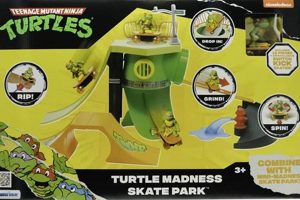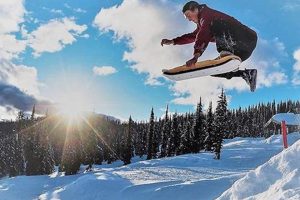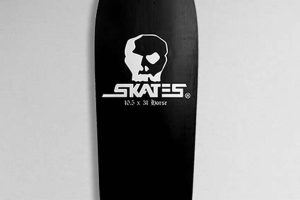This specific type of sporting equipment combines elements of skateboarding and surfing, offering an extended deck length for stability and cruising. Sector 9, a prominent manufacturer, produces these boards catering to a diverse range of riders, from beginners to experienced individuals seeking downhill speed or leisurely rides. The components often include a maple or bamboo deck, responsive trucks for turning, and soft wheels designed for smooth rolling over varied surfaces.
These products deliver a blend of recreation, transportation, and exercise. They provide a low-impact activity suitable for improving balance, coordination, and core strength. The Sector 9 brand, established in the early 1990s, contributed significantly to the popularization and evolution of this segment of skateboarding, introducing innovative designs and materials that influenced the wider industry. Its focus on quality and performance has made it a recognized name among enthusiasts.
The following sections will delve into the various factors one should consider when selecting one of these skateboards, including deck construction, truck types, wheel characteristics, and the specific riding styles each configuration is best suited for. Understanding these elements is essential for making an informed decision and maximizing enjoyment of the sport.
Tips for Optimal Use
Selecting and utilizing this equipment requires careful consideration to ensure safety and maximize performance. The following tips provide guidance on various aspects of ownership and operation.
Tip 1: Deck Material Selection: Consider the deck material based on riding style. Maple decks offer durability and stiffness for aggressive riding, while bamboo provides flex for a smoother, more comfortable cruise. A heavier rider may benefit from the increased rigidity of a maple deck.
Tip 2: Truck Tightness Adjustment: Properly adjust truck tightness to match desired turning radius and stability. Looser trucks allow for tighter turns but reduce stability at higher speeds; conversely, tighter trucks offer greater stability but limit maneuverability. Experimentation is required to find the optimal setting.
Tip 3: Wheel Durometer Consideration: Select wheel durometer (hardness) appropriate for riding surface. Softer wheels (lower durometer) provide better grip and absorption of vibrations on rough surfaces, while harder wheels (higher durometer) offer faster rolling speed on smooth surfaces. Terrain dictates the ideal durometer.
Tip 4: Protective Gear Utilization: Always wear appropriate protective gear, including a helmet, knee pads, elbow pads, and wrist guards. Head injuries are a significant risk associated with longboarding, and protective gear significantly mitigates the severity of potential injuries.
Tip 5: Pre-Ride Inspection: Conduct a thorough pre-ride inspection of all components, including deck integrity, truck tightness, wheel condition, and hardware security. Loose or damaged components can compromise safety and performance.
Tip 6: Weight Distribution Practice: Master weight distribution techniques to maintain balance and control. Shifting weight forward initiates turns, while leaning back helps maintain stability during descents. Practice is crucial for developing muscle memory and instinctive reactions.
These suggestions highlight the importance of informed decision-making regarding equipment selection, maintenance, and safety practices. Adherence to these guidelines enhances the riding experience and minimizes potential risks.
The next section will address common misconceptions surrounding this activity and provide clarifications based on factual information.
1. Deck Material Composition
The deck material significantly influences the performance characteristics of a longboard manufactured by Sector 9. The choice between materials such as maple, bamboo, or composite constructions directly affects flex, durability, and overall riding experience. For example, maple, a common choice, provides a stiff and robust platform suitable for downhill riding and aggressive maneuvers. A stiffer deck translates to increased stability at high speeds, a characteristic often sought by experienced longboarders navigating challenging terrains. Sector 9 often uses multiple plies of maple to achieve a desired balance of strength and responsiveness.
Bamboo, in contrast, offers greater flexibility, resulting in a smoother, more forgiving ride. This material excels in cruising and carving applications where responsiveness and comfort are paramount. Sector 9 incorporates bamboo into some of its models to cater to riders prioritizing a relaxed, flowing experience. Furthermore, certain decks might employ composite materials, blending the properties of different substances to optimize specific attributes like weight reduction or vibration dampening. The selection of deck material is, therefore, not arbitrary but a deliberate engineering decision to align the boards performance with its intended use.
Ultimately, understanding the connection between deck material composition and a Sector 9 longboards performance is crucial for making an informed purchasing decision. Selecting a deck material that aligns with the intended riding style ensures optimal performance, comfort, and longevity of the board. Disregarding this aspect could result in a suboptimal riding experience, potentially compromising safety and enjoyment. Therefore, prospective buyers should carefully consider the trade-offs associated with each material before committing to a purchase.
2. Truck System Geometry
The truck system geometry is a foundational element influencing the handling characteristics of a Sector 9 longboard. Its design directly impacts turning responsiveness, stability, and overall riding experience. The specific configuration of the trucks dictates how the board reacts to rider input and affects its suitability for different riding styles.
- Kingpin Angle
The angle of the kingpin significantly affects turning responsiveness. Lower angles offer greater stability, preferred for high-speed downhill riding. Higher angles increase turning agility, ideal for carving and cruising. Sector 9 offers trucks with varying kingpin angles, allowing riders to select a setup tailored to their specific needs. A lower kingpin angle will generally result in a less responsive turn, but increased stability at higher speeds.
- Truck Width
Truck width influences stability and leverage. Wider trucks provide a more stable platform, particularly beneficial for beginners or those seeking increased control at speed. Narrower trucks offer enhanced maneuverability, facilitating tighter turns and carving. Sector 9 longboards are typically equipped with trucks matched to the deck width to optimize performance characteristics. An incorrectly sized truck can dramatically affect the ride feel.
- Bushing Durometer
Bushing durometer, or hardness, impacts resistance to turning. Softer bushings allow for easier turning with less effort, suitable for carving and cruising. Harder bushings provide increased stability and resistance to unwanted movement, preferred for downhill riding. Sector 9 utilizes bushings of varying durometers, allowing riders to fine-tune the responsiveness of their trucks. The specific durometer required depends on the rider’s weight and riding style.
- Pivot Cup Material
The pivot cup, a small but crucial component, influences turning smoothness and reduces friction. High-quality materials, such as urethane, minimize wear and tear and contribute to a more responsive and predictable ride. Sector 9 often employs durable pivot cups in its trucks to ensure consistent performance over time. Worn or damaged pivot cups can negatively impact turning precision.
These facets collectively determine the performance characteristics of Sector 9 longboard trucks. Understanding how these elements interact allows riders to make informed decisions when selecting or modifying their equipment. Optimizing truck system geometry enhances the riding experience and improves safety across various disciplines. Ignoring these factors can lead to a suboptimal setup that detracts from performance and increases the risk of accidents.
3. Wheel Durometer Rating
The wheel durometer rating serves as a critical specification directly influencing the performance characteristics of a Sector 9 longboard. Measured on the A scale, this rating quantifies the wheel’s hardness, impacting factors such as grip, speed, and vibration absorption. Selecting an appropriate durometer is essential for optimizing the riding experience and ensuring suitability for intended riding conditions. The specific number dictates not only the feel of the ride, but also the applicability to various terrains.
- Grip vs. Speed Trade-off
Lower durometer wheels (e.g., 78A – 82A) exhibit increased grip due to their softer composition. This is advantageous for carving and cruising, particularly on rough surfaces, as the increased grip facilitates tighter turns and enhanced control. Sector 9 boards designed for carving often incorporate softer wheels to maximize maneuverability. Conversely, higher durometer wheels (e.g., 83A and above) offer reduced rolling resistance and increased speed, making them suitable for downhill riding and smoother surfaces. The trade-off is a reduction in grip, requiring greater rider skill to maintain control. Selecting the appropriate durometer necessitates balancing the need for grip against the desire for speed. A 78A wheel will have far less speed than an 83A and up, making the surface ridden on extremely important.
- Vibration Absorption and Comfort
Softer wheels, characterized by lower durometer ratings, excel at absorbing vibrations and mitigating surface imperfections. This contributes to a smoother and more comfortable ride, particularly on uneven terrain. Sector 9 longboards intended for recreational cruising typically utilize softer wheels to minimize rider fatigue and enhance the overall experience. Harder wheels transmit more vibrations to the rider, resulting in a less comfortable ride, especially over extended distances. Because of this, knowing the area being ridden in will assist in comfort and ride quality.
- Wear Resistance and Longevity
Higher durometer wheels generally exhibit greater wear resistance compared to softer wheels. The harder composition withstands abrasion and degradation, resulting in extended lifespan, particularly under demanding riding conditions. Sector 9 longboards intended for aggressive riding or frequent use may benefit from harder wheels to minimize the need for replacement. Softer wheels wear down more rapidly, especially when subjected to slides or sharp turns. Because of this, rotating them can also extend the overall lifespan of the wheels.
- Surface Compatibility
The durometer rating influences wheel performance across different surfaces. Softer wheels provide superior grip and control on rough or uneven surfaces, while harder wheels excel on smooth, paved surfaces where speed is prioritized. Sector 9 offers a range of wheel durometers to accommodate diverse riding environments. Selecting a wheel durometer that aligns with the prevailing surface conditions optimizes performance and enhances rider safety. The smoothness of the surface is directly related to the durometer and desired riding experience.
In conclusion, the wheel durometer rating represents a crucial parameter in the selection and configuration of a Sector 9 longboard. Understanding the trade-offs between grip, speed, comfort, and wear resistance is essential for optimizing the riding experience and ensuring suitability for intended riding conditions. The choice of durometer must align with both the rider’s skill level and the typical riding environment to maximize performance and safety. The proper durometer can mean the difference between a long ride with control and many falls on the pavement.
4. Bearing Precision Grade
Bearing precision grade, often specified using the ABEC (Annular Bearing Engineers’ Committee) scale or similar ISO standards, significantly affects the performance of a Sector 9 longboard. This rating system quantifies manufacturing tolerances, influencing rolling efficiency, speed, and the overall smoothness of the ride. A higher precision grade generally indicates tighter tolerances and superior performance, although other factors also contribute to bearing quality and longevity.
- ABEC Rating and Rolling Efficiency
The ABEC scale ranges from 1 to 9, with odd numbers only (1, 3, 5, 7, 9). A higher ABEC rating suggests that the bearing was manufactured to tighter tolerances. Bearings with higher ABEC ratings tend to roll more smoothly and efficiently, translating to increased speed and reduced effort for the rider. For example, a Sector 9 longboard equipped with ABEC 7 bearings will generally maintain momentum more effectively than one with ABEC 3 bearings, all other factors being equal. However, beyond a certain point, the performance gains from increasing the ABEC rating diminish, and other factors such as lubrication and bearing material become more critical.
- Impact on Speed and Acceleration
Bearing precision influences a longboard’s acceleration and top speed. Higher precision bearings, due to their reduced friction, allow the board to accelerate more quickly and maintain higher speeds with less effort. This is particularly relevant for downhill riding or long-distance cruising, where minimizing rolling resistance is paramount. Sector 9 longboards designed for high-speed applications often utilize bearings with higher ABEC ratings to maximize performance. A small difference in bearing precision can translate to a noticeable improvement in speed and acceleration, especially over extended distances.
- Durability and Maintenance Considerations
While a higher ABEC rating indicates greater precision, it does not necessarily guarantee increased durability. Bearing durability is influenced by factors such as material quality, lubrication, and exposure to contaminants. High-precision bearings may be more susceptible to damage from impacts or debris if not properly maintained. Sector 9 recommends regular cleaning and lubrication of bearings to maintain optimal performance and extend their lifespan. Selecting bearings with appropriate seals or shields can also help protect them from dirt and moisture.
- Cost vs. Performance Trade-offs
Bearings with higher ABEC ratings typically command a higher price. While the performance benefits of higher precision bearings can be significant, the cost may not be justified for all riders. For casual cruising or recreational use, bearings with lower ABEC ratings may provide adequate performance at a lower price point. Sector 9 offers longboards with a range of bearing options to cater to different budgets and performance requirements. Determining the appropriate balance between cost and performance is essential when selecting bearings for a longboard.
The bearing precision grade is a significant factor influencing the performance of a Sector 9 longboard. While higher precision bearings can offer increased speed and rolling efficiency, other factors such as durability, maintenance, and cost must also be considered. Selecting bearings that align with the rider’s skill level, riding style, and budget is crucial for optimizing the overall longboarding experience. Furthermore, regular maintenance and proper care are essential for maximizing the lifespan and performance of any bearing, regardless of its precision grade.
5. Riding Style Compatibility
The suitability of a particular Sector 9 longboard hinges significantly on its compatibility with the rider’s intended riding style. Selecting a board ill-suited to the intended activity can result in diminished performance, increased difficulty, and potentially heightened risk. The following considerations outline key aspects of this compatibility.
- Cruising and Carving
Cruising and carving styles prioritize comfort, stability, and responsiveness for leisurely rides and gentle turns. For this, Sector 9 longboards with flexible decks (often constructed from bamboo), softer wheels (around 78A-82A durometer), and responsive trucks are ideal. The flexible deck absorbs vibrations, the softer wheels provide grip on varied surfaces, and the responsive trucks allow for smooth, controlled turns. A stiffer downhill board would feel cumbersome and less enjoyable for this purpose. Imagine attempting to navigate a winding boardwalk on a stiff, unforgiving board; the experience would be jarring and require significantly more effort.
- Downhill Riding
Downhill riding demands stability, control, and speed at higher velocities. In this context, Sector 9 longboards with stiff decks (typically multiple plies of maple), harder wheels (83A durometer and above), and stable trucks with lower kingpin angles are essential. The stiff deck minimizes flex at high speeds, the harder wheels reduce rolling resistance, and the stable trucks maintain control during rapid descents. Attempting downhill on a flexible cruising board would induce speed wobbles and severely compromise stability, potentially leading to accidents.
- Freestyle and Dancing
Freestyle and dancing involve performing tricks, spins, and intricate footwork on the longboard. Sector 9 boards designed for this purpose often feature a symmetrical shape, a moderate flex, and ample deck space for movement. Wheel wells are often present to prevent wheel bite during sharp turns and slides. The balance between flex and stiffness allows for both trick execution and stable landings. Attempting freestyle on a stiff downhill board would restrict movement and make trick execution considerably more challenging.
- Commuting
Commuting requires a balance of comfort, portability, and efficiency. Sector 9 longboards suitable for commuting might feature a shorter deck length for easier carrying, medium-durometer wheels for a balance of speed and grip, and a kicktail for navigating urban obstacles. A board designed exclusively for downhill would be impractical for carrying on public transportation or maneuvering through crowded sidewalks.
The aforementioned facets illustrate the critical importance of aligning a Sector 9 longboard with the rider’s intended riding style. Selecting a board based solely on aesthetics or price, without considering its intended use, can result in a suboptimal and potentially unsafe riding experience. Careful consideration of deck flex, wheel durometer, truck configuration, and overall board geometry is essential for maximizing enjoyment and ensuring suitability for the chosen discipline. Therefore, prospective buyers should thoroughly research and assess their individual needs and preferences before committing to a purchase, or risk buying an unusable board.
Frequently Asked Questions
This section addresses common inquiries and provides factual clarifications regarding Sector 9 longboards, aiming to provide a clear and concise understanding of these products.
Question 1: What is the typical lifespan of a Sector 9 longboard deck?
The lifespan of a Sector 9 longboard deck varies significantly based on usage frequency, riding style, and storage conditions. With proper care and moderate use, a deck can last for several years. However, aggressive riding, exposure to moisture, and improper storage can significantly shorten its lifespan. Regular inspection for cracks or delamination is recommended.
Question 2: How does wheel durometer affect the performance of a Sector 9 longboard?
Wheel durometer, measured on the A scale, directly impacts grip, speed, and vibration absorption. Softer wheels (lower durometer) provide greater grip and vibration absorption, ideal for cruising. Harder wheels (higher durometer) offer increased speed but reduced grip, suitable for downhill riding. Selecting the appropriate durometer is crucial for optimizing performance and safety.
Question 3: What maintenance is required for Sector 9 longboard trucks?
Regular maintenance of Sector 9 longboard trucks includes cleaning, lubrication, and inspection for wear or damage. Bushings should be inspected for cracks or deterioration and replaced as needed. Kingpin nuts should be checked and tightened periodically to prevent loosening. Proper maintenance ensures optimal performance and longevity of the trucks.
Question 4: Are Sector 9 longboards suitable for beginners?
Sector 9 offers a range of longboards suitable for various skill levels, including beginners. Boards designed for cruising and carving are generally more stable and easier to control, making them a good choice for new riders. However, proper safety gear, including a helmet, is essential regardless of skill level.
Question 5: How does deck material influence the riding experience on a Sector 9 longboard?
Deck material, such as maple or bamboo, affects flex, durability, and vibration absorption. Maple decks provide stiffness and stability, suitable for downhill riding. Bamboo decks offer greater flex, resulting in a smoother and more comfortable ride for cruising. The choice of material should align with the intended riding style.
Question 6: What factors should be considered when selecting bearings for a Sector 9 longboard?
Bearing selection should consider precision grade (ABEC rating), material quality, and seal type. Higher ABEC ratings indicate greater precision, leading to smoother and faster rolling. Selecting bearings with appropriate seals can protect them from dirt and moisture, extending their lifespan. Regular cleaning and lubrication are also crucial for maintaining bearing performance.
In summary, understanding the specific features, components, and maintenance requirements of Sector 9 longboards is essential for making informed decisions and ensuring a safe and enjoyable riding experience.
The following section will provide resources for further information and support.
Conclusion
This exploration of skate longboard sector 9 has detailed critical aspects pertinent to selection, maintenance, and optimal utilization. Understanding deck materials, truck geometry, wheel durometer, and bearing precision is fundamental to aligning equipment with intended riding styles and skill levels. Safety considerations, particularly the use of protective gear and regular equipment inspection, are non-negotiable for responsible participation in this activity.
Continued advancements in materials science and manufacturing techniques will undoubtedly shape the future of this equipment. Emphasizing informed decision-making, adherence to safety protocols, and a commitment to responsible riding will foster a positive environment for continued innovation and participation within the skateboarding community.







